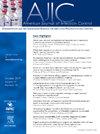Improving hand hygiene in hospitals: A comparative study using body-worn cameras and direct observation
IF 2.4
3区 医学
Q2 INFECTIOUS DISEASES
引用次数: 0
Abstract
Background
Hand hygiene (HH) prevents infections, but traditional monitoring is limited by office hours and the Hawthorne effect. We used body-worn cameras in ICU to compare video with direct observation.
Methods
After ethics approval, staff wore a GoPro™ on the upper abdomen during patient care. A trained observer simultaneously documented opportunities and performance. A blinded researcher analyzed the video. Both methods were compared on opportunities, compliance, performance, and duration.
Results
Seventeen paired video and observer data sets captured 166 HH opportunities and 147 events. Of these, 118/147 (80%) were in response to a HH opportunity and 29/147 not (20%). Including HH performance-related to events, overall HH compliance was 71%. Both methods identified 80% of opportunities. Video detected 11.5% of missed opportunities, while the observer identified 8.5% missed by video. Mean duration was comparable (11.3±9.2 sec vs. 12.0±9.8 sec, p=0.55).
Discussion
Body-worn cameras effectively identified HH opportunities, performance, and duration, capturing events missed by observers ~20% of the time. However, video analysis had flaws, revealing missed events upon review. Observer data, long considered the gold-standard, showed only 80% accuracy.
Conclusions
Body-worn cameras are a feasible tool for HH monitoring, but are labor-intensive. Automating video analysis could enhance feasibility for routine use.
改善医院手部卫生:使用随身相机与直接观察的比较研究。
背景:手卫生(HH)可以预防感染,但传统的监测受到办公时间和霍桑效应的限制。本研究在icu中使用穿戴式摄像机来比较视频与直接观察。方法:经伦理批准后,医护人员在患者护理过程中在上腹部佩戴GoPro™记录HH。训练有素的观察员同时记录机会和业绩。一名盲法研究人员随后分析了这段视频。两种方法通过四个参数进行比较:机会、依从性、性能和持续时间。结果:17个配对的视频和观察者数据集捕获了166个HH机会和147个事件。其中,118/147例(80%)是为了应对手卫生机会而进行的,29/147例(20%)不是。包括与事件相关的HH表现,总体HH依从性为118/166(71%)。两种方法都能识别80%的机会。视频发现了11.5%的错失机会,而观察者发现了8.5%的错失机会。平均持续时间可比较(视频:11.3±9.2秒,观察者:12.0±9.8秒,p=0.55)。讨论:随身摄像机有效地识别HH机会,表现和持续时间,捕捉到观察者错过的事件约20%的时间。然而,视频分析有缺陷,在审查时发现遗漏的事件。长期以来被视为黄金标准的观察者数据显示,准确率只有80%。结论:随身摄像机是一种可行的HH监测工具,但其劳动强度较大。自动化视频分析可以提高日常使用的可行性。
本文章由计算机程序翻译,如有差异,请以英文原文为准。
求助全文
约1分钟内获得全文
求助全文
来源期刊
CiteScore
7.40
自引率
4.10%
发文量
479
审稿时长
24 days
期刊介绍:
AJIC covers key topics and issues in infection control and epidemiology. Infection control professionals, including physicians, nurses, and epidemiologists, rely on AJIC for peer-reviewed articles covering clinical topics as well as original research. As the official publication of the Association for Professionals in Infection Control and Epidemiology (APIC)

 求助内容:
求助内容: 应助结果提醒方式:
应助结果提醒方式:


